The global powdered cellulose market is valued at USD 202.8 million in 2025 and is anticipated to reach USD 327.2 million by 2035, recording an absolute increase of USD 124.4 million over the forecast period. This translates into a total growth of 61.3%, with the market forecast to expand at a compound annual growth rate (CAGR) of 4.9% between 2025 and 2035.
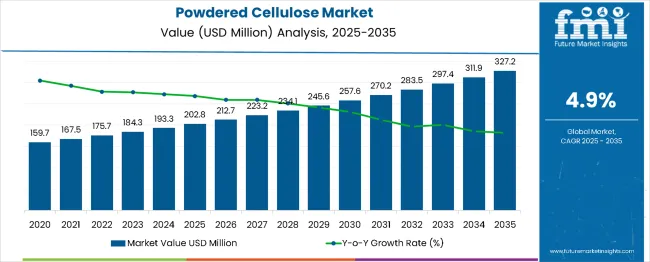
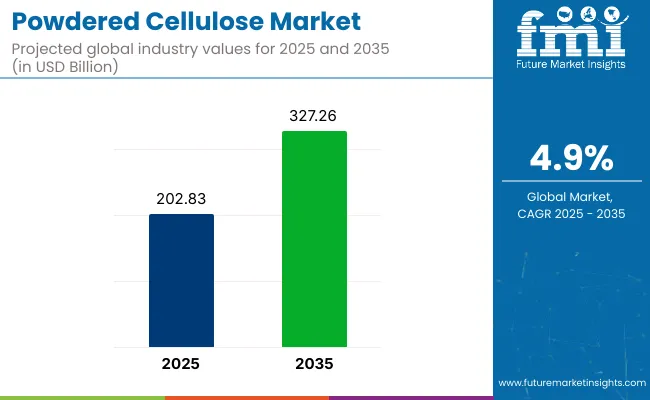
Powdered Cellulose Market Key Takeaways
| Metric | Value |
|---|---|
| Estimated Value in (2025E) | USD 202.8 million |
| Forecast Value in (2035F) | USD 327.2 million |
| Forecast CAGR (2025 to 2035) | 4.9% |
The overall market size is expected to grow by nearly 1.61X during the same period, supported by increasing demand for natural food additives, growing pharmaceutical excipient applications, and rising adoption of cellulose-based ingredients in clean-label formulations across diverse industrial applications.
Between 2025 and 2030, the powdered cellulose market is projected to expand from USD 202.8 million to USD 257.8 million, resulting in a value increase of USD 55.0 million, which represents 44.2% of the total forecast growth for the decade. This phase of development will be shaped by increasing demand for clean-label food ingredients, rising pharmaceutical excipient requirements, and growing adoption of natural additives in processed food manufacturing. Food manufacturers and pharmaceutical companies are expanding their powdered cellulose utilization to address consumer preferences for natural ingredients and regulatory requirements for safe food additives.
From 2030 to 2035, the market is forecast to grow from USD 257.8 million to USD 327.2 million, adding another USD 69.4 million, which constitutes 55.8% of the overall ten-year expansion. This period is expected to be characterized by the expansion of pharmaceutical-grade applications, the integration of sustainable sourcing practices, and the development of specialized cellulose formulations for advanced industrial applications. The growing emphasis on biodegradable and environmentally friendly ingredients will drive demand for powdered cellulose products derived from sustainable raw materials with enhanced functional properties.
Between 2020 and 2024, the powdered cellulose market experienced steady growth, driven by increasing consumer demand for natural food additives and growing recognition of cellulose's functional benefits as a texturing agent, anti-caking additive, and dietary fiber source. The market developed as food manufacturers recognized the potential for powdered cellulose to improve product texture while meeting clean-label requirements. Technological advancement in processing methods and particle size optimization began emphasizing the critical importance of maintaining functional properties while ensuring food safety and regulatory compliance.
The coming years are transformative for powdered cellulose. As consumers and regulators push for more natural, sustainable, and health-oriented ingredients, powdered cellulose stands to benefit as a functional, plant-based additive in multiple sectors.
Food & beverage formulators want thickeners, stabilizers, and bulking agents that are clean-label and non-allergenic; pharmaceutical and supplement makers need reliable excipients; personal care brands seek hypoallergenic, plant-derived alternatives; and industrial users demand moisture control, film formation, and binding properties with low environmental impact.
Technological improvements in processing, particle sizing, source variations (non-wood fibers), and cost reduction will amplify uptake. Emerging markets will contribute disproportionately to growth as incomes rise, regulation aligns, and localized production becomes feasible. Regulatory drivers around health (e.g. fiber, reducing synthetic additives) and sustainability (carbon footprint, deforestation) will further push demand.
Market expansion is being supported by the increasing global demand for natural and clean-label ingredients and the corresponding shift away from synthetic additives that can provide similar functional benefits while meeting consumer preferences for recognizable and natural food components.
Modern food and pharmaceutical manufacturers are increasingly focused on incorporating powdered cellulose to enhance product functionality while satisfying regulatory requirements and consumer expectations for natural ingredient formulations. Powdered cellulose's proven ability to deliver texture improvement, moisture control, and anti-caking properties makes it an essential ingredient for clean-label product development and functional food applications.
The growing emphasis on pharmaceutical excipient applications is driving demand for high-purity powdered cellulose that can support tablet manufacturing, controlled-release formulations, and specialized drug delivery systems. Manufacturer preference for ingredients that combine functional versatility with regulatory acceptance is creating opportunities for innovative powdered cellulose implementations across pharmaceutical, food, and industrial applications.
The rising influence of sustainability trends and biodegradable material requirements is also contributing to increased adoption of cellulose-based products that can provide environmentally friendly alternatives to synthetic additives.
The market is segmented by grade, source, end-use industry, and region. By grade, the market is divided into food grade, pharmaceutical grade, and industrial grade. Based on the source, the market is categorized into soft & hard wood pulp, cotton linter pulp, bamboo, wheat straw pulp, and other sources.
By end-use industry, the market includes food & beverage, pharmaceuticals, cosmetics, construction industry, chemical industry, leather industry, textile industry, paper industry, and others. Regionally, the market is divided into North America, Europe, East Asia, South Asia & Pacific, Latin America, and the Middle East & Africa.
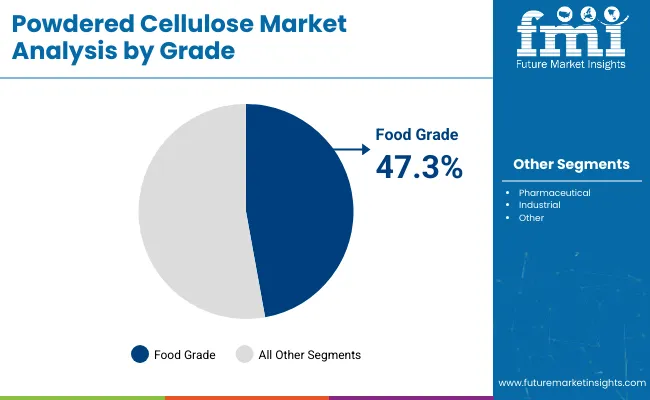
The food-grade segment is projected to account for 40.0% of the powdered cellulose market in 2025, reaffirming its position as the leading grade category. Food manufacturers increasingly utilize food-grade powdered cellulose for its excellent anti-caking properties, texture enhancement capabilities, and ability to function as a natural dietary fiber additive while meeting strict food safety regulations. Food-grade cellulose technology's regulatory approval and consumer acceptance directly address the industry requirements for clean-label formulations and natural ingredient positioning.
This grade segment forms the foundation of modern food additive applications, as it represents the category with the greatest regulatory approval and established safety profile across multiple food product categories. Manufacturer investments in purity enhancement and particle size optimization continue to strengthen adoption among food processors.
With food companies prioritizing clean-label positioning and natural ingredients, food-grade powdered cellulose aligns with both consumer preferences and regulatory compliance objectives, making it the central component of comprehensive natural food additive strategies.
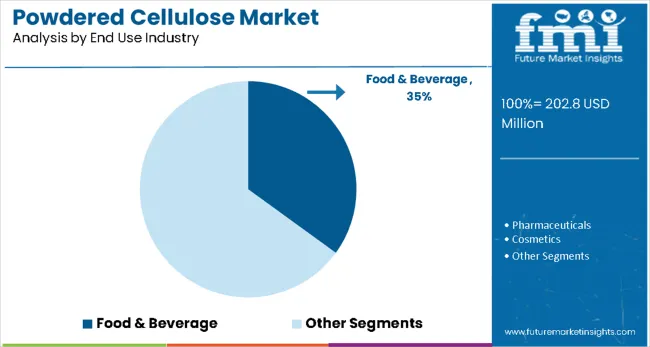
Food & beverage applications are projected to represent 35.0% of powdered cellulose demand in 2025, underscoring their critical role as the primary industrial application for cellulose-based functional additives. Food manufacturers prefer powdered cellulose for its versatile functionality, natural origin, and ability to improve product texture while reducing fat content and enhancing dietary fiber profiles. Positioned as essential ingredients for modern food processing, powdered cellulose offers both functional advantages and clean-label benefits.
The segment is supported by continuous innovation in food formulation technologies and the growing availability of specialized cellulose grades that enable optimized performance in specific food applications. Additionally, food manufacturers are investing in natural ingredient sourcing to support clean-label product development and consumer health positioning.
As natural ingredient demand continues to grow and functional food requirements increase, food & beverage applications will continue to dominate the end-use market while supporting advanced formulation capabilities and health-conscious product development.
The powdered cellulose market is advancing steadily due to increasing consumer demand for natural food ingredients and growing adoption of cellulose-based excipients in pharmaceutical formulations that provide functional benefits while meeting clean-label and regulatory requirements.
However, the market faces challenges, including raw material price volatility, complex processing requirements for pharmaceutical grades, and competition from alternative natural additives. Innovation in sustainable sourcing and specialized processing technologies continues to influence product development and market expansion patterns.
Expansion of Pharmaceutical Applications
The growing adoption of powdered cellulose in pharmaceutical excipient applications is enabling drug manufacturers to develop tablets, capsules, and controlled-release formulations with improved stability, bioavailability, and manufacturing efficiency.
Pharmaceutical applications provide enhanced product functionality while allowing more sophisticated drug delivery systems across various therapeutic areas and dosage forms. Pharmaceutical companies are increasingly recognizing the competitive advantages of cellulose-based excipients for regulatory compliance and product performance optimization.
Integration of Sustainable Sourcing Practices
Modern powdered cellulose producers are incorporating sustainable raw material sourcing, renewable resource utilization, and environmentally responsible processing methods to enhance product positioning and meet growing demand for eco-friendly ingredients.
These practices improve brand differentiation while enabling new applications, including organic and sustainable product certifications. Advanced sustainability integration also allows manufacturers to support premium market positioning and corporate responsibility objectives beyond traditional cellulose production methods.
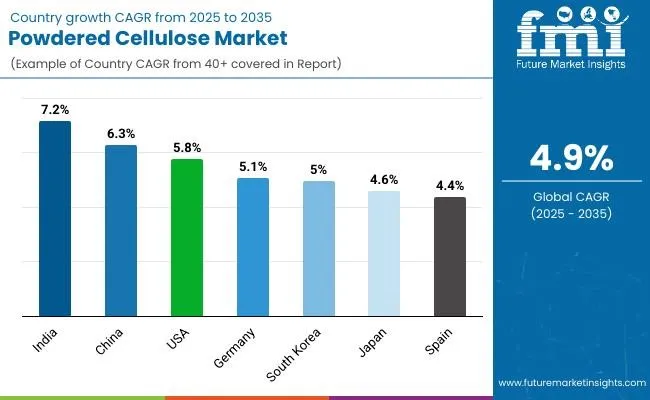
| Country | CAGR (2025 to 2035) |
|---|---|
| India | 7.2% |
| China | 6.3% |
| USA | 5.8% |
| Germany | 5.1% |
| South Korea | 5.0% |
| Japan | 4.6% |
| Spain | 4.4% |
The powdered cellulose market is experiencing robust growth globally, with India leading at a 7.2% CAGR through 2035, driven by the expanding food processing industry, the growing pharmaceutical manufacturing sector, and the increasing adoption of natural food additives in processed food production. China follows at 6.3%, supported by large-scale manufacturing capabilities, growing consumer health awareness, and an expanding pharmaceutical industry.
The USA shows growth at 5.8%, emphasizing clean-label food trends and advanced pharmaceutical applications. Germany records 5.1%, focusing on high-quality pharmaceutical excipients and premium food ingredients. South Korea demonstrates 5.0% growth, prioritizing natural food additive adoption and pharmaceutical market development.
Japan exhibits 4.6% growth, supported by advanced food technology and pharmaceutical innovation. Spain shows 4.4% growth, emphasizing food processing modernization and natural ingredient adoption.
The report covers an in-depth analysis of 40+ countries; seven top-performing countries are highlighted below.
Revenue from powdered cellulose in India is projected to exhibit exceptional growth with a CAGR of 7.2% through 2035, driven by the rapidly expanding food processing industry and increasing consumer demand for processed foods with natural additives.
The country's growing pharmaceutical manufacturing sector and government support for food processing development are creating substantial demand for high-quality cellulose products. Major food manufacturers and pharmaceutical companies are establishing comprehensive sourcing strategies to serve both domestic consumption and export market requirements.
Revenue from powdered cellulose in China is expanding at a CAGR of 6.3%, supported by large-scale manufacturing infrastructure, growing health awareness among consumers, and the expanding pharmaceutical industry requiring high-quality excipients.
The country's comprehensive supply chain capabilities and cost-effective production methods are driving demand for diverse cellulose applications. International ingredient companies and domestic manufacturers are establishing extensive production and distribution capabilities to address growing domestic and export market demand.
Revenue from powdered cellulose in the USA is projected to grow at a CAGR of 5.8% through 2035, driven by established clean-label food trends, the advanced pharmaceutical industry, and consumer preference for natural and functional ingredients.
The country's sophisticated regulatory environment and innovation capabilities are creating substantial demand for high-quality cellulose products across food and pharmaceutical applications. Leading ingredient companies and food manufacturers are establishing comprehensive product portfolios to serve evolving market requirements.
Revenue from powdered cellulose in Germany is projected to grow at a CAGR of 5.1% through 2035, supported by the advanced pharmaceutical industry, stringent quality standards, and established food ingredient manufacturing capabilities.
German manufacturers prioritize product quality, regulatory compliance, and technical innovation, making powdered cellulose essential for both pharmaceutical excipients and premium food applications. The country's export-oriented approach continues to drive market development and quality enhancement initiatives.
Revenue from powdered cellulose in South Korea is projected to grow at a CAGR of 5.0% through 2035, supported by the expanding food processing industry, the growing pharmaceutical sector, and increasing consumer awareness of natural ingredient benefits.
The country's abundant raw material resources and developing manufacturing capabilities are creating opportunities for cellulose market expansion. Food manufacturers and pharmaceutical companies are investing in natural ingredient adoption to meet evolving consumer preferences.
Revenue from powdered cellulose in Japan is projected to grow at a CAGR of 4.6% through 2035, supported by advanced food technology, innovative pharmaceutical applications, and sophisticated consumer preferences for high-quality ingredients.
Japanese manufacturers' focus on precision and quality creates steady demand for premium cellulose products across both food and pharmaceutical sectors. The country's technical expertise drives continuous innovation in cellulose applications and processing methods.
Revenue from powdered cellulose in Spain is projected to grow at a CAGR of 4.4% through 2035, supported by food processing industry modernization, growing natural ingredient adoption, and expanding pharmaceutical manufacturing capabilities. Spanish food manufacturers are increasingly incorporating natural additives to meet consumer demands for clean-label products and improved nutritional profiles. The country's strategic location supports both domestic consumption and export market development.
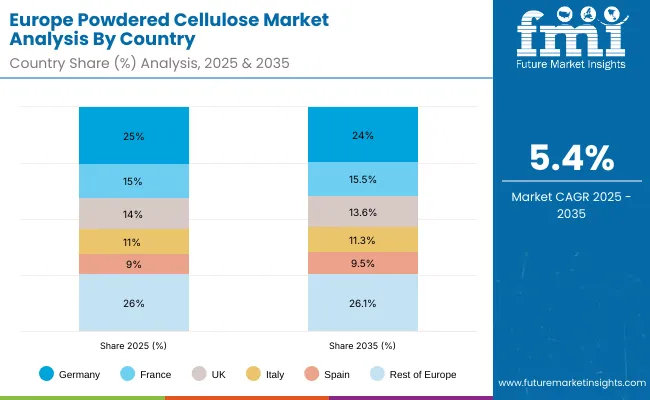
The powdered cellulose market in Europe is projected to grow from USD 40.4 million in 2025 to USD 65.3 million by 2035, registering a CAGR of 4.9% over the forecast period. Germany is expected to maintain its leadership position with a 25.0% market share in 2025, declining slightly to 24.0% by 2035, supported by its strong pharmaceutical formulation industry, advanced food ingredient manufacturing base, and comprehensive quality assurance capabilities serving European and international markets.
France follows with a 15.0% share in 2025, projected to reach 15.5% by 2035, driven by bakery and confectionery innovations, growing specialty food ingredient adoption, and an established pharmaceutical industry requiring high-quality excipients. The United Kingdom holds a 14.0% share in 2025, expected to decrease to 13.6% by 2035, supported by clean-label food trends and pharmaceutical applications but facing challenges from regulatory alignment and post-Brexit trade dynamics.
Italy commands an 11.0% share in 2025, projected to reach 11.3% by 2035, while Spain accounts for 9.0% in 2025, expected to reach 9.5% by 2035. The Netherlands maintains a 4.0% share in 2025, growing to 4.2% by 2035. The Rest of Europe region, including Nordic countries, Eastern Europe, Portugal, Belgium, Switzerland, and Austria, is anticipated to hold 26.0% in 2025, maintaining 26.1% by 2035, attributed to expanding manufacturing capabilities in Eastern European markets, balanced by stabilizing demand in some Western European countries implementing advanced food processing and pharmaceutical manufacturing programs.
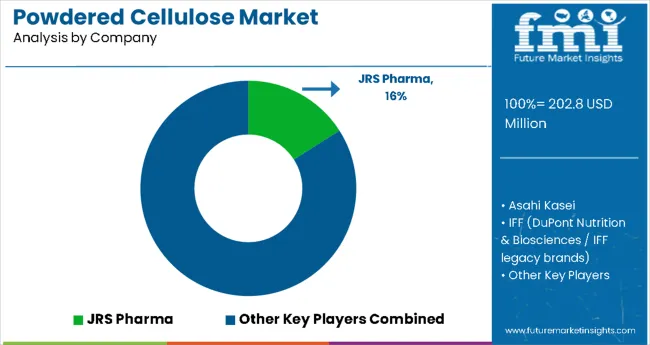
The powdered cellulose market is characterized by competition among established specialty chemical companies, pharmaceutical excipient manufacturers, and integrated cellulose processors. Companies are investing in processing technology research, quality standardization programs, sustainable sourcing initiatives, and comprehensive regulatory compliance to deliver consistent, high-purity, and functionally optimized powdered cellulose products. Innovation in particle size control, surface modification, and application-specific formulations is central to strengthening market position and customer satisfaction.
JRS Pharma leads the market with a strong focus on pharmaceutical excipients and functional food ingredients, offering comprehensive cellulose solutions with emphasis on quality assurance and regulatory compliance. Asahi Kasei provides integrated chemical solutions with a focus on advanced processing technologies and global distribution capabilities.
IFF (DuPont Nutrition & Biosciences) delivers innovative ingredient solutions with a focus on food applications and nutritional enhancement. Ingredion focuses on food ingredient development with emphasis on functionality and clean-label positioning. Ashland Global Specialty Chemicals specializes in pharmaceutical excipients with emphasis on performance optimization. Daicel Corporation offers comprehensive cellulose derivatives with a focus on industrial and pharmaceutical applications.
The success of powdered cellulose, driven by demand for functional food ingredients, pharmaceutical excipients, and sustainable materials, will not only enhance product performance across industries but also strengthen supply chain circularity by valorizing wood and agricultural residues.
It will consolidate emerging markets as suppliers of low-cost cellulose while aligning advanced economies with clean-label and eco-friendly ingredient sourcing. This calls for a concerted effort by all stakeholders: governments, industry bodies, suppliers, OEMs, and investors. Each can be a crucial enabler in preparing the market for its next phase of growth.
| Items | Values |
|---|---|
| Quantitative Units (2025) | USD 202.8 Million |
| Grade | Food Grade, Pharmaceutical Grade, Industrial Grade |
| Source | Soft & Hard Wood Pulp, Cotton Linter Pulp, Bamboo, Wheat Straw Pulp, Other Sources |
| End-Use Industry | Food & Beverage, Pharmaceuticals, Cosmetics, Construction Industry, Chemical Industry, Leather Industry, Textile Industry, Paper Industry, Others |
| Regions Covered | North America, Europe, East Asia, South Asia & Pacific, Latin America, Middle East & Africa |
| Countries Covered | United States, Canada, United Kingdom, Germany, France, China, Japan, South Korea, India, South Korea, Australia and 40+ countries |
| Key Companies Profiled | JRS Pharma, Asahi Kasei, IFF (DuPont Nutrition & Biosciences), Ingredion, Ashland Global Specialty Chemicals, Daicel Corporation, Lenzing AG, Nippon Paper Industries, Sappi Limited, and Domsjö Fabriker |
| Additional Attributes | Dollar sales by grade and end-use industry, regional demand trends, competitive landscape, technological advancements in processing methods, sustainable sourcing initiatives, regulatory compliance requirements, and application-specific formulation development |
North America
Europe
East Asia
South Asia & Pacific
Latin America
Middle East & Africa
The global powdered cellulose market is expected to reach USD 327.26 million by 2035, up from USD 202.83 million in 2025, growing at a CAGR of 4.9% during the forecast period.
Food-grade powdered cellulose is set to lead the market with a 47.3% share in 2025, owing to its widespread use in bakery, dairy, and processed food for fat replacement, moisture retention, and fiber enrichment.
The thickener functionality segment is projected to account for 34.1% of market share in 2025, driven by its widespread use in food, pharmaceuticals, and cosmetics for consistent texture, heat stability, and label-friendly appeal.
Bamboo-based powdered cellulose is forecasted to grow at the fastest CAGR of 6.5% from 2025 to 2035, supported by its renewable profile, low environmental impact, and strong uptake in food packaging and sustainable applications.
Key players include J. Rettenmaier & Söhne GmbH + Co KG, CFF GmbH & Co. KG, Jelu-Werk J. Heeler GmbH & Co KG, InterFiber Sp. Z.O.O, Ankit Pulps and Boards Pvt. Ltd., and FineCell Sweden AB, all focusing on clean-label innovations and eco-friendly cellulose solutions.






Our Research Products

The "Full Research Suite" delivers actionable market intel, deep dives on markets or technologies, so clients act faster, cut risk, and unlock growth.

The Leaderboard benchmarks and ranks top vendors, classifying them as Established Leaders, Leading Challengers, or Disruptors & Challengers.

Locates where complements amplify value and substitutes erode it, forecasting net impact by horizon

We deliver granular, decision-grade intel: market sizing, 5-year forecasts, pricing, adoption, usage, revenue, and operational KPIs—plus competitor tracking, regulation, and value chains—across 60 countries broadly.

Spot the shifts before they hit your P&L. We track inflection points, adoption curves, pricing moves, and ecosystem plays to show where demand is heading, why it is changing, and what to do next across high-growth markets and disruptive tech

Real-time reads of user behavior. We track shifting priorities, perceptions of today’s and next-gen services, and provider experience, then pace how fast tech moves from trial to adoption, blending buyer, consumer, and channel inputs with social signals (#WhySwitch, #UX).

Partner with our analyst team to build a custom report designed around your business priorities. From analysing market trends to assessing competitors or crafting bespoke datasets, we tailor insights to your needs.
Supplier Intelligence
Discovery & Profiling
Capacity & Footprint
Performance & Risk
Compliance & Governance
Commercial Readiness
Who Supplies Whom
Scorecards & Shortlists
Playbooks & Docs
Category Intelligence
Definition & Scope
Demand & Use Cases
Cost Drivers
Market Structure
Supply Chain Map
Trade & Policy
Operating Norms
Deliverables
Buyer Intelligence
Account Basics
Spend & Scope
Procurement Model
Vendor Requirements
Terms & Policies
Entry Strategy
Pain Points & Triggers
Outputs
Pricing Analysis
Benchmarks
Trends
Should-Cost
Indexation
Landed Cost
Commercial Terms
Deliverables
Brand Analysis
Positioning & Value Prop
Share & Presence
Customer Evidence
Go-to-Market
Digital & Reputation
Compliance & Trust
KPIs & Gaps
Outputs
Full Research Suite comprises of:
Market outlook & trends analysis
Interviews & case studies
Strategic recommendations
Vendor profiles & capabilities analysis
5-year forecasts
8 regions and 60+ country-level data splits
Market segment data splits
12 months of continuous data updates
DELIVERED AS:
PDF EXCEL ONLINE
Korea Powdered Cellulose Market Analysis by Source, End-use, Functionality, and Region Through 2035
Japan Powdered Cellulose Market, By Type, By Application, By Region, and Forecast, 2025 to 2035
Demand for Powdered Cellulose in EU Size and Share Forecast Outlook 2025 to 2035
Western Europe Powdered Cellulose Market Analysis by Source, End-use, Functionality, and Country Through 2035
Cellulose Diacetate Film Market Size and Share Forecast Outlook 2025 to 2035
Cellulose Fiber Market Forecast and Outlook 2025 to 2035
Cellulose Derivative Market Size and Share Forecast Outlook 2025 to 2035
Cellulose Film Packaging Market Size and Share Forecast Outlook 2025 to 2035
Cellulose Ether and Derivatives Market Size and Share Forecast Outlook 2025 to 2035
Cellulose Esters Market Size and Share Forecast Outlook 2025 to 2035
Cellulose Nanocrystals and Nanofibers Market Size and Share Forecast Outlook 2025 to 2035
Powdered Soft Drinks Market Size and Share Forecast Outlook 2025 to 2035
Cellulose Gel Market Growth, Forecast, and Analysis 2025 to 2035
Market Share Insights for Cellulose Fiber Providers
Key Players & Market Share in Cellulose Film Packaging Market
Powdered Fats Market – Growth, Demand & Industrial Applications
Powdered Beverage Market Outlook – Growth, Demand & Forecast 2024-2034
Powdered Hand Soap Market
Nanocellulose Coating Market Analysis - Size and Share Forecast Outlook 2025 to 2035
Nanocellulose Barrier Coating Market Analysis - Size and Share Forecast Outlook 2025 to 2035

Thank you!
You will receive an email from our Business Development Manager. Please be sure to check your SPAM/JUNK folder too.
Chat With
MaRIA